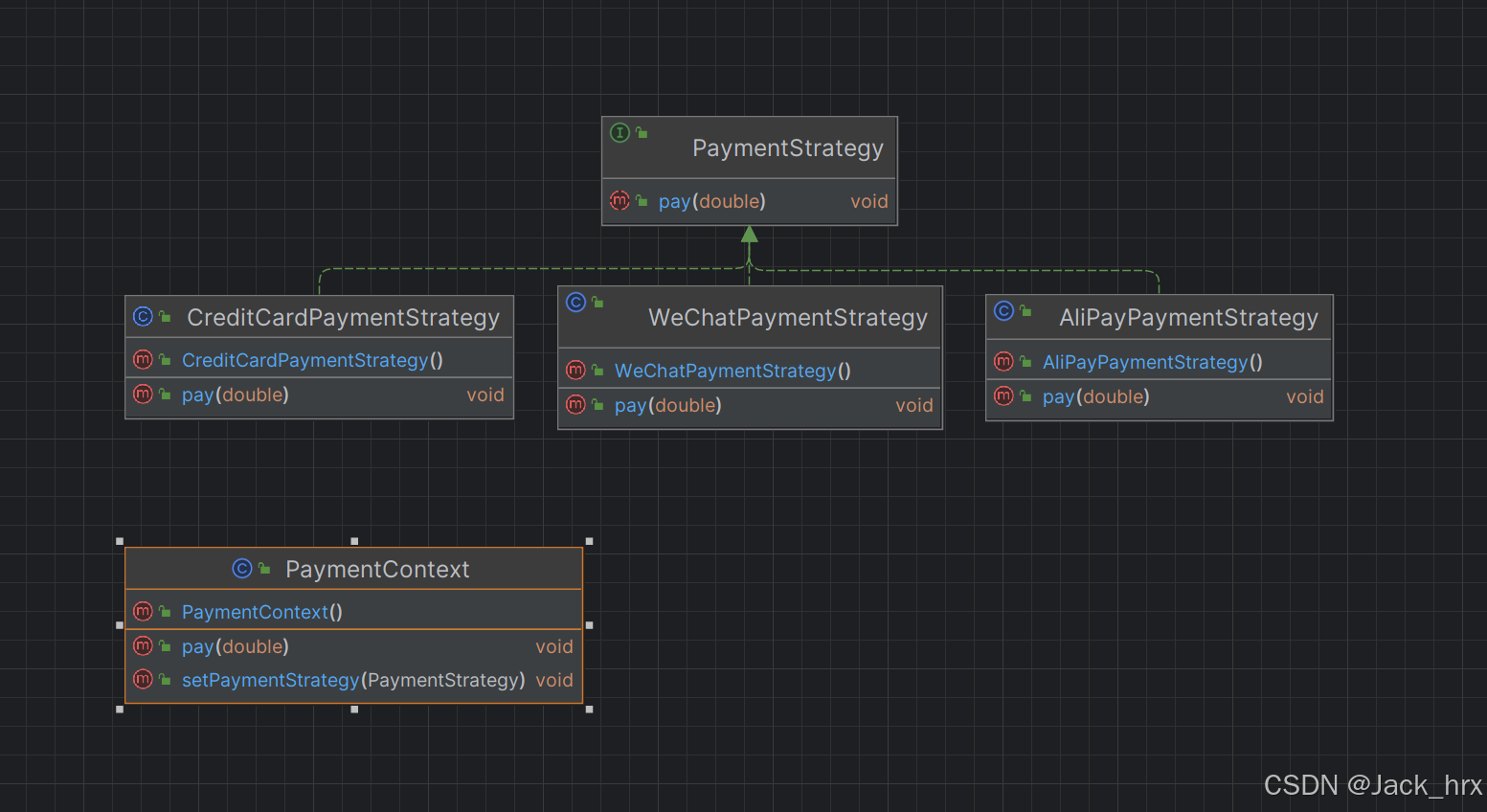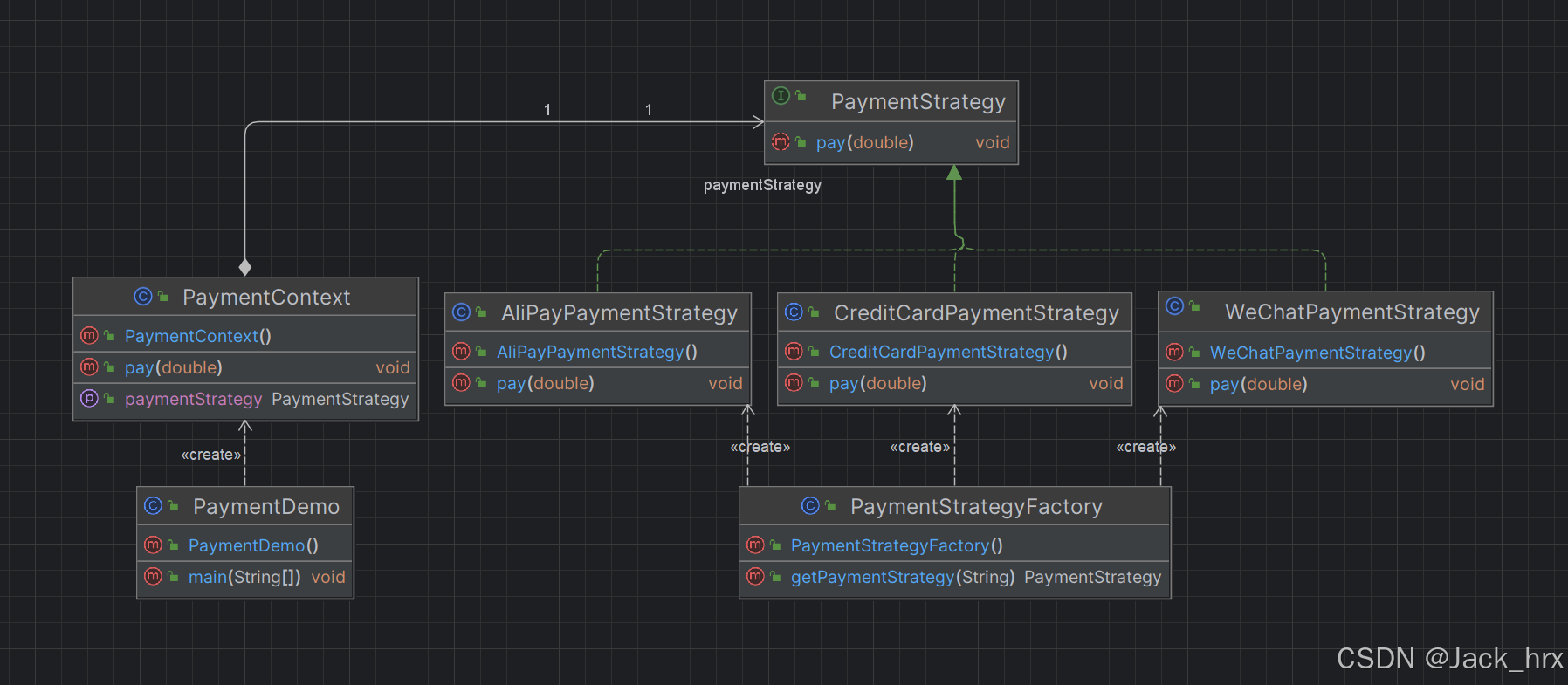Java 设计模式之策略模式 (Strategy Pattern) 详解
策略模式(Strategy Pattern)是一种行为型设计模式,旨在定义一系列算法,将每个算法封装起来,并使它们可以互相替换,从而使得算法的变化不会影响使用算法的客户端。策略模式的主要结构包括策略接口、具体策略类和上下文类,通过将算法的选择与使用分离,实现了代码的可维护性和灵活性。
更多设计模式请参考:Java 中的 23 种设计模式详解
1. 策略模式的动机
在软件开发中,经常遇到需要在运行时动态选择一种算法的情况。例如,排序算法、支付方式、文件压缩等场景都可能需要在不同条件下选择不同的算法实现。如果在客户端代码中硬编码这些算法的选择逻辑,会导致代码难以维护和扩展。策略模式通过将算法的选择和实现分离,使得算法可以独立变化,客户端代码可以更简洁和灵活。
2. 策略模式的结构
策略模式包含以下几部分:
- 策略接口(Strategy Interface):定义所有支持的算法的公共接口。
- 具体策略类(Concrete Strategies):实现策略接口,定义具体的算法。
- 上下文类(Context Class):使用一个具体策略对象来配置,并维护对策略对象的引用。
3. 策略模式的UML类图

4. 策略模式的实现
以下是一个使用策略模式的Java示例,该示例演示了如何选择不同的策略来执行操作:
4.1 策略接口
// 定义策略接口 public interface Strategy { void execute(); } 4.2 具体策略类
// 具体策略A public class ConcreteStrategyA implements Strategy { @Override public void execute() { System.out.println("执行策略A"); } } // 具体策略B public class ConcreteStrategyB implements Strategy { @Override public void execute() { System.out.println("执行策略B"); } } 4.3 上下文类
// 上下文类 public class Context { private Strategy strategy; // 设置策略 public void setStrategy(Strategy strategy) { this.strategy = strategy; } // 执行策略 public void executeStrategy() { if (strategy == null) { throw new IllegalStateException("Strategy未设置"); } strategy.execute(); } } 4.4 客户端代码
public class StrategyPatternDemo { public static void main(String[] args) { Context context = new Context(); // 使用策略A context.setStrategy(new ConcreteStrategyA()); context.executeStrategy(); // 输出: 执行策略A // 使用策略B context.setStrategy(new ConcreteStrategyB()); context.executeStrategy(); // 输出: 执行策略B } } 5. 策略模式的优缺点
优点
- 算法可以自由切换:可以在不影响客户端的情况下更改算法。
- 避免多重条件判断:使用策略模式可以避免过多的if-else或switch-case语句。
- 扩展性好:增加新的策略时只需添加新的策略类即可,不需要修改现有代码。
缺点
- 客户端必须知道所有的策略类:客户端需要了解每个策略类的具体实现,这增加了复杂度。
- 增加对象数目:如果策略较多,会增加类的数量,导致系统变得复杂。
6. 策略模式的应用场景
策略模式适用于以下场景:
- 需要在不同情况下使用不同的算法。
- 有许多相关类仅仅在行为上有所不同。
- 需要避免使用复杂的条件语句来选择不同的行为。
7. 策略模式的变体
策略模式可以与其他设计模式结合使用,以增强其功能。例如:
- 组合模式(Composite Pattern):可以将策略模式与组合模式结合,使得策略的选择更加灵活。
- 工厂模式(Factory Pattern):可以使用工厂模式来创建策略对象,从而实现策略的动态选择。
8. 策略模式与其他设计模式的比较
- 策略模式 vs. 状态模式:两者结构类似,但策略模式的不同策略是彼此独立的,而状态模式的不同状态之间存在一定的关系。
- 策略模式 vs. 命令模式:命令模式用于封装请求,将请求与执行解耦,而策略模式用于封装算法,将算法与使用算法的代码解耦。
9. 策略模式的实现细节与最佳实践
9.1 延迟初始化策略
在某些情况下,策略的初始化可能比较耗时,可以使用延迟初始化(Lazy Initialization)来提高性能:
public class Context { private Strategy strategy; public void setStrategy(Strategy strategy) { this.strategy = strategy; } public void executeStrategy() { if (strategy == null) { // 延迟初始化 strategy = new ConcreteStrategyA(); } strategy.execute(); } } 9.2 使用反射动态加载策略
为了避免频繁修改代码,可以通过反射动态加载策略:
public class Context { private Strategy strategy; public void setStrategy(String strategyClassName) throws Exception { this.strategy = (Strategy) Class.forName(strategyClassName).getDeclaredConstructor().newInstance(); } public void executeStrategy() { strategy.execute(); } } 9.3 使用配置文件管理策略
将策略的配置放在配置文件中,便于管理和维护:
# strategy.properties strategy=ConcreteStrategyA import java.io.InputStream; import java.util.Properties; public class StrategyLoader { public static Strategy loadStrategy() throws Exception { Properties properties = new Properties(); try (InputStream input = StrategyLoader.class.getResourceAsStream("/strategy.properties")) { properties.load(input); } String strategyClassName = properties.getProperty("strategy"); return (Strategy) Class.forName(strategyClassName).getDeclaredConstructor().newInstance(); } } 9.4 策略模式与依赖注入
结合依赖注入框架(如Spring),可以更加灵活地管理策略的实例:
import org.springframework.beans.factory.annotation.Autowired; import org.springframework.stereotype.Component; @Component public class Context { private final Strategy strategy; @Autowired public Context(Strategy strategy) { this.strategy = strategy; } public void executeStrategy() { strategy.execute(); } } 10. 策略模式的实际应用案例

10.1 支付系统中的策略模式
在一个支付系统中,可能有多种支付方式,如信用卡支付、支付宝支付、微信支付等。通过策略模式,可以根据用户选择的支付方式动态切换支付策略。
支付策略接口
public interface PaymentStrategy { void pay(double amount); } 具体支付策略类
// 信用卡支付策略 public class CreditCardPaymentStrategy implements PaymentStrategy { @Override public void pay(double amount) { System.out.println("使用信用卡支付:" + amount + "元"); } } // 支付宝支付策略 public class AliPayPaymentStrategy implements PaymentStrategy { @Override public void pay(double amount) { System.out.println("使用支付宝支付:" + amount + "元"); } } // 微信支付策略 public class WeChatPaymentStrategy implements PaymentStrategy { @Override public void pay(double amount) { System.out.println("使用微信支付:" + amount + "元"); } } 支付上下文类
public class PaymentContext { private PaymentStrategy paymentStrategy; // 设置支付策略 public void setPaymentStrategy(PaymentStrategy paymentStrategy) { this.paymentStrategy = paymentStrategy; } // 执行支付 public void pay(double amount) { if (paymentStrategy == null) { throw new IllegalStateException("PaymentStrategy未设置"); } paymentStrategy.pay(amount); } } 支付策略工厂类
为了更加优雅地创建支付策略,可以使用工厂模式:
public class PaymentStrategyFactory { public static PaymentStrategy getPaymentStrategy(String type) { switch (type) { case "CreditCard": return new CreditCardPaymentStrategy(); case "AliPay": return new AliPayPaymentStrategy(); case "WeChat": return new WeChatPaymentStrategy(); default: throw new IllegalArgumentException("未知的支付类型: " + type); } } } 客户端代码
public class PaymentDemo { public static void main(String[] args) { PaymentContext context = new PaymentContext(); // 从外部获取支付类型,例如通过用户输入或配置文件 String paymentType = "CreditCard"; // 这里可以根据实际情况更改 // 使用工厂创建支付策略 PaymentStrategy paymentStrategy = PaymentStrategyFactory.getPaymentStrategy(paymentType); // 设置支付策略 context.setPaymentStrategy(paymentStrategy); // 执行支付 context.pay(100.0); // 输出: 使用信用卡支付:100.0元 // 更改支付策略 paymentType = "AliPay"; paymentStrategy = PaymentStrategyFactory.getPaymentStrategy(paymentType); context.setPaymentStrategy(paymentStrategy); context.pay(200.0); // 输出: 使用支付宝支付:200.0元 // 更改支付策略 paymentType = "WeChat"; paymentStrategy = PaymentStrategyFactory.getPaymentStrategy(paymentType); context.setPaymentStrategy(paymentStrategy); context.pay(300.0); // 输出: 使用微信支付:300.0元 } } 优化的重点
- 工厂模式:使用工厂模式来创建支付策略对象,使客户端代码更简洁,策略的创建和选择更灵活。
- 空策略检查:在上下文类中增加对策略是否为空的检查,避免未设置策略时的运行时错误。
- 策略类型动态获取:通过从外部(如用户输入或配置文件)获取支付类型,示例代码更加接近实际应用场景。
通过策略模式和工厂模式的结合,可以实现一个灵活、可扩展且易于维护的支付系统。在实际开发中,进一步结合依赖注入框架(如Spring)来管理策略对象,可以提升代码的可测试性和可扩展性。
